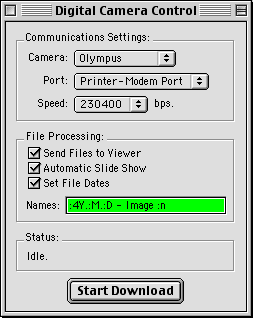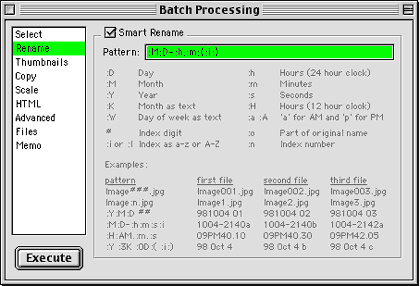Review: Cameraid 1.1.2

Product Information
Written by Juri Munkki
E-Mail: jmunkki@iki.fi
Web: http://www.cameraid.com
Shareware Fee: $15 ($250 site license)
System Requirements
Macintosh with a 68020 or newer processor (also PowerPC native)
System 7.1 or later, QuickTime, at least 2 MB of application RAM
Supported Cameras: Agfa ePhoto, Apple QuickTake 200, Epson, Fujifilm, Leica, Nikon Coolpix 900,
Olympus, Sanyo, Toshiba
Digital cameras are becoming more and more common. Although they still cannot fully replace the point-and-shoot film cameras, there are increasing uses for digital pictures. Two aspects are especially appealing: you do not need traditional film that has to be constantly replaced, and you “immediately” have the pictures in a digital form that you can work on. Instead of requiring you to develop the film and then scan the pictures, you can simply connect the camera to the computer and download the pictures.
But it is not as simple as that. Anyone who has connected a digital camera through the serial port, especially the new mega-pixel cameras with huge image sizes, knows that it can take forever for the pictures to load into the computer. The reason is that most software that comes with the cameras limits the transfer speed of the serial port to 56 kilobits per second (or about 7,000 bytes per second). When you have to download 30 images, of 280,000 bytes each, this can take quite a while, between about 20 to 40 minutes. What is worse, most of that software does not let you use the computer during that time. So you have to sit there for 40 minutes, patiently waiting for the pictures to slowly trickle in.
Cameraid, on the other hand, lets you use the full 224 kilobit/sec that most Macs offer. That is a full 28,800 bytes per second, or about four times faster. Instead of taking 20 to 40 minutes to download, Cameraid gets the job done in 5 to 10 minutes. Even better, Cameraid downloads in the background, letting you use the computer during the download. This saves serious time. I estimate that I have gained two days in my life simply by using the faster download. Sometimes it is even the only possibility. The software that came with my Olympus camera refused to recognize the serial port of my PowerBook all together, and does not even want to talk to the Keyspan serial adapter that I use to load the pictures into the iMac. I might have to note that I can only get the standard 56kbps with the Keyspan adapter on the iMac, but that is better than nothing at all.

This alone would deserve a lot of praise, but there is so much more. Some people do not use a serial connection to get the pictures into their computer, using a floppy or a memory card reader instead (which is much faster than any serial connection, even with Cameraid). Even they will get to enjoy these features that make Cameraid a must for the serious or casual digital camera user.
I have given up my traditional camera for a digital camera, and all the pictures I ever made are in a couple of folders. There are around 2000 pictures in these folders, and I am constantly adding more. It is crucially important to stay organized. Cameraid is tremendously helpful in this respect.
As you download the pictures or drop them on Cameraid from the Finder, it opens them in the “Viewer,” the central piece of the interface. The viewer shows every open picture, one at a time, and you can easily open hundreds before you run out of memory. It also shows additional information about the picture like its size and the date it was taken, as well as the shutter speed with which it was taken, provided that the camera includes that information. From there you can manipulate an individual image, or all images currently in the viewer at once.
You can scroll through the list of images in the viewer by using the scroll bars or the left and right arrow keys on the keyboard. When you come to an image that needs to be rotated, you can simply press , to rotate left or . to rotate right (or choose the commands from the menu). Cameraid provides lossless JPEG rotation, i.e. you do not lose quality when rotating the image. This is not self-evident. Cameraid was the first shareware program for the Mac to introduce this and, with the exception of Graphic Converter now, is the only one. As you download the images from the camera, it adds them one by one to the viewer and you can rotate them as you go. The whole process, especially with the keyboard shortcuts is very efficient.
 Cameraid also lets you specify
the exact filenames of the images
it downloads. Specifying
“:4Y.:M.:D - Image :n” as the
filename, tells Cameraid to name
every image like
“1999.03.27 - Image 01",
changing the date and index as
you download the images. The
possibilities for the name are
nearly endless and well
explained in the program.
Cameraid also lets you specify
the exact filenames of the images
it downloads. Specifying
“:4Y.:M.:D - Image :n” as the
filename, tells Cameraid to name
every image like
“1999.03.27 - Image 01",
changing the date and index as
you download the images. The
possibilities for the name are
nearly endless and well
explained in the program.
Once you have the images properly rotated and named, you can modify them further. You have full control over how Cameraid displays and sorts the images. The most useful feature is the batch processor. It allows you to perform operations on the whole batch of images in the viewer. Some of the operations available are:
- Select (selects certain images in the viewer)
- Rename (the same naming function as at the download)
- Thumbnails (lets you create custom thumbnails and previews for the images)
- Copy (lets you copy all images to a new folder and perform various image enhancement functions on them as they are copied)
- Scale (lets you resize the images by a certain factor, or to a certain maximum width and height)
- HTML Web Page Generator (creates an HTML-based album so you can easily enjoy the pictures of share them with others through the Internet)
- Advanced (more image enhancements)

If you use the same batch processor a lot, you can save it and put it in the shortcut menu.
There are some more functions, like the advanced “Grade” menu that lets you select and choose images in a more refined way. Many of the more advanced functions will require you to read the easy to understand manual (also available online at http://www.cameraid.com/cameraid/manual). The beauty of Cameraid is that you do not need to understand all the functions to use the program productively. The complexity is well hidden and you can expand your knowledge of the program as needed. Many common functions are already included in the shortcuts menu. The interface is very well done, and the program is very fast. The Finnish programmer has taken a lot of care to make the program work well, and you can literally see the love he put into it. This is a program you do not want to be without if you use digital cameras more than once a year. I wholeheartedly recommend it; it is simply excellent.
![]() Copyright © 1999 Daniel Chvatik, dchvatik@atpm.com. Reviewing in ATPM
is open to anyone. Contact reviews@atpm.com for more information.
Copyright © 1999 Daniel Chvatik, dchvatik@atpm.com. Reviewing in ATPM
is open to anyone. Contact reviews@atpm.com for more information.
Reader Comments (0)
Add A Comment